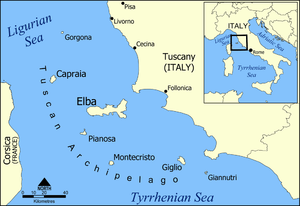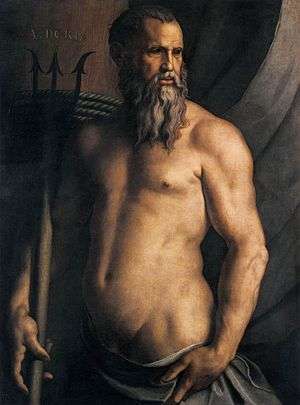Battle of Pianosa
Coordinates: 42°48′N 10°00′E / 42.800°N 10.000°E
| Battle of Pianosa | |||||||
|---|---|---|---|---|---|---|---|
| Part of the wars of the Christian powers against the Barbary Corsairs | |||||||
.jpg) | |||||||
| |||||||
| Belligerents | |||||||
|
| Tunisian corsairs | ||||||
| Commanders and leaders | |||||||
|
| Kaid Ali (POW) | ||||||
| Strength | |||||||
|
| ||||||
| Casualties and losses | |||||||
|
| ||||||

The Battle of Pianosa is a naval engagement which took place on April 25, 1519 when a Genoese fleet inflicted a severe defeat on the flotilla of the Tunisia-based Barbary corsair Kaid Ali in the Tyrrhenian Sea, in view of the island of Elba. The battle broke the back of one of the rising corsair bases on the Barbary Coast, Bizerte, and established Andrea Doria as one of the foremost captains in the Mediterranean .
Background
Raiding had for long been part of the life of the Mediterranean, the last decades of the Middle Ages had seen numerous famous corsairs harassing both the coastal populations and shipping activities, but the turn of the 16th century coincides with a marked surge of the phenomenon.[1][2] Most notably, several captains established bases on the North African coast where strong corsair flotillas leave every years for months-long cruises.[3] During the spring and summer, they raid and pillage the coastal regions and the maritime trade of Mediterranean Europe.[4] Among the most famous Barbary corsairs of the region at the time are Hayreddin Barbarossa and Kurtoğlu Muslihiddin.[5] The latter set up his base of operation in the Tunisian town of Bizerte with the support of the local Hafsid Dynasty. The prowess of Kurtoğlu at sea attracts the attention of the Ottoman government and he is offered the command of the Turkish fleet in 1516. After Kurtoğlu Muslihiddin leaves North Africa, command in Bizerte is assumed by another captain (reis), Kaid Ali (literally Ali the Boss) who soon prooves as much a scourge for the Europeans as his predecessor had been.[6] The Bizertine flotilla has grown strong enough to be a threat not only for the merchant ships and the coast villages but even for military vessels. In a battle in mid September 1518, Kaid Ali thus manages to defeat and capture the flagship galley (Capitana) of the Pope and to take the admiral of the papal fleet, Paolo Vettori, near Mont’Argentario, on the Tuscan coast.[7]
For the most part the European Christian powers are too occupied fighting each other to pay much heed to the rather small-scale predation of the Barbary corsairs. Spain, for instance, notably diminishes the resources allocated to the fight against the North African raiders during the 1510s, considering French expansionism as a much greater threat to its security.[8] The corsairs are only taken seriously by lesser coastal powers such as Genoa and the Papal States in particular because they directly menace the all-important trade routes upon which their economies and grain supplies depend.[9][10] In the early spring 1519, aware of the arrival of Kaid Ali's flotilla in the Tyrrhenian Sea, the Genoese Republic entrusts the defence of its coastline to a local captain, the nobleman Andrea Doria, who has acquired a good reputation fighting in Corsica for the Republic. Mindful of the difficulty of the task at hand, Andrea Doria, demands that the four galleys of the Republic be reinforced with an other two. His request is granted by the Genoese government but, as there were not enough prisoners and captives to provide the necessary rowers to the two new boats, free oarsmen are recruited (known as buonavoglia) to complement the rowing crew.[11]
The battle
The Genoese fleet leaves its base mid April and heads south into the Tyrrhenian Sea looking for corsairs. On April 25, in the Tuscan archipelago, near the island of Pianosa, the Genoese ships meet the flotilla of Kaid Ali. More numerous and with the support of a favourable strong southern wind (sirocco), the Barbary corsairs are at a clear advantage. Andrea Doria has his galleys turn face and flee while the Bizertine begin to pursue. The chase goes on for about 20 nautical miles and probably 4 hours. The strong wind puts the larger and more sea-worthy Genoese ships at an advantage. They reach the westernmost cape of the island of Elba ahead of their pursuers.[12]
Having reached Elba, the Genoese captain takes advantage of a local wind pattern to change direction and head straight towards the Bizertines. However, the newly recruited free-rowers of the two additional ships lack the skill and strength for these arduous manoeuvres and begin drifting with the wind. Andrea Doria must send two of his older galleys to tow the less experienced ships. Two-thirds of the Genoese ships are unable to face-off and run down the adversary in a timely fashion. Rather than letting the opportunity pass, Andrea Doria puts his nephew Filippino Doria in charge of the four slower ships and takes his main galleys, the Capitana and the Patrona straight towards the Bizertine to pin them down before the main force arrives.[13][14]
The Genoese have more artillery than the corsairs and manage to do some damage with their canons. But the Bizertine succeed in grappling the Genoese ships and to board them. Hand-to-hand combat ensues. Badly outnumbered, Doria and his men manage to sustain the shock for fifteen minutes. At this point the four ships under Filippino Doria reach the thick of the fight and within half-an-hour the battle is won for the Genoese. Only three fustes of the corsairs manage to get away, the rest of the flotilla – possibly as many as 9 vessels of various sizes – is captured or sunk. The Capitana of the Pope has been recovered and his towed back to Genoa along with four other ships.[15]
Aftermath
The fight, as is often the case on the overcrowded galleys, has been extraordinarily violent and bloody. Italian sources mention 500 corsairs dead, this may be an overestimate but the losses on the side of the Bizertines are undoubtedly heavy. The Genoese have also suffered important casualties. One of Andrea Doria's nephew, Lazzarino Doria is killed in action and his second-in-command Filippino Doria is wounded twice.[16][17] The Genoese only manage to take a handful of prisoners among whom, however, is the Bizertine captain Kaid Ali. Most of these captive are rapidly ransomed but Kaid Ali himself is not exchanged and is kept as prisoner in the fortress of Pianosa until his death, in 1530.
With Kaid Ali prisoner and Kurtoğlu Muslihiddin serving the Ottomans in the East, the bulk of their men dead and most of their ships captured or sunk, the strength of the Bizertine corsair base has been broken and the city recedes to the status of a very secondary raiding bases, far behind the main corsair ports Tripoli and, above all, Algiers.
References
- ↑ Valérian 2006, p. 421 et seg.
- ↑ Graziani 1991, p. 477
- ↑ Bono 1964, p. passim
- ↑ Braudel 1995, p. 251
- ↑ Zachariadou 2002, p. passim
- ↑ Guglielmotti 1876, p. 161
- ↑ Grazziani 2008, p. 69
- ↑ Espinosa 2005, p. 249
- ↑ Pacini 1999, p. 59
- ↑ Grendi 1970, p. passim
- ↑ Guglielmotti 1876, p. 165
- ↑ Guglielmotti 1876, p. 165
- ↑ Guglielmotti 1876, p. 165
- ↑ Williams 2015, p. 87 et seg
- ↑ Guglielmotti 1876, p. 165
- ↑ Guglielmotti 1876, p. 166
- ↑ Grazziani 2008, p. 70
Bibliography
- Bono, Salvatore (1964). I corsari barbareschi. Rome: ERI-Edizion RAI Radiotelevisione Italiana.
- Braudel, Fernand (1995). The Mediterranean and the Mediterranean World in the Age of Philip II, Volume 1. Berkeley, CA: University of California Press.
- Campodonico, Pierangelo (1997). Andrea Doria. Genoa: Tormena Editore.
- Cavanna Ciappina, Maristella (1982). "Doria, Filippo". Dizionario Biografico degli Italiani - Volume 41.
- Espinosa, Aurelio (2005). "The Grand Strategy of Charles V (1500-1558): Castile, War, and Dynastic Priority in the Mediterranean". Journal of Early Modern History. 9 (3): 239–283.
- Graziani, Antoine-Marie (1991). "Domaines coloniaux, industrie sécuritaire et système fiscal en Corse à la fin du XVIe siècle". Mélanges de l'Ecole française de Rome. Italie et Méditerranée. 103 (2): 461–520.
- Graziani, Antoine-Marie (2008). Andrea Doria: Un Prince de la Renaissance. Paris: Tallandier.
- Grendi, Edoardo (2005). "Genova alla meta del Cinquecento: una politica del grano?". Journal of Early Modern History. 5 (13): 106–160. JSTOR 43900349.
- Guglielmotti, Alberto (1876). Storia della marina Pontificia dal secolo ottavo al decimonono, Volume 3, Issue 1. Rome: Tipografia Tiberina.
- Lo Basso, Luca (2007). "Gli asentisti del re. L'esercizio privato della guerra nelle strategie economiche dei Genovesi (1528-1716)" (PDF). R. Cancila. Mediterraneo in armi. Mediterranea. Palermo: 2712–81.
- Pacini, Arturo (1999). La Genova di Andrea Doria nell'impero di Carlo V. Florence: Olschki. * Valérian, Dominique (2006). Bougie, port maghrébin, 1067-1510. Rome: Ecole Française de Rome.
- Zachariadou, Elisavet A. ed. (2002). The Kapudan Pasha : his office and his domain : Halcyon Days in Crete IV, a symposium held in Rethymnon, 7-9 January 2000. Rethymnon: Crete University Press.
- Williams, Phillip (2015). Empire and Holy War in the Mediterranean: The Galley and Maritime Conflict Between the Habsburgs and Ottomans. New York City: I. B. Tauris.

